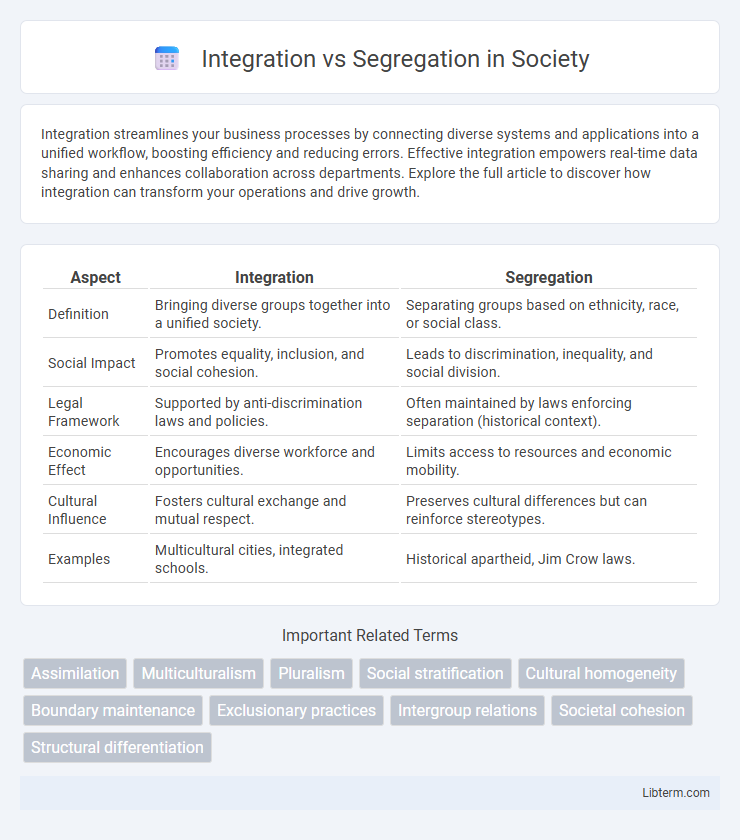Integration streamlines your business processes by connecting diverse systems and applications into a unified workflow, boosting efficiency and reducing errors. Effective integration empowers real-time data sharing and enhances collaboration across departments. Explore the full article to discover how integration can transform your operations and drive growth.
Table of Comparison
| Aspect | Integration | Segregation |
|---|---|---|
| Definition | Bringing diverse groups together into a unified society. | Separating groups based on ethnicity, race, or social class. |
| Social Impact | Promotes equality, inclusion, and social cohesion. | Leads to discrimination, inequality, and social division. |
| Legal Framework | Supported by anti-discrimination laws and policies. | Often maintained by laws enforcing separation (historical context). |
| Economic Effect | Encourages diverse workforce and opportunities. | Limits access to resources and economic mobility. |
| Cultural Influence | Fosters cultural exchange and mutual respect. | Preserves cultural differences but can reinforce stereotypes. |
| Examples | Multicultural cities, integrated schools. | Historical apartheid, Jim Crow laws. |
Understanding Integration and Segregation
Integration and segregation refer to the processes of combining or separating groups based on characteristics such as race, ethnicity, or socio-economic status. Integration promotes inclusion and equal access to resources by blending diverse populations within shared environments like schools or neighborhoods. Segregation enforces physical or social separation, leading to disparities in opportunity, social cohesion, and access to services.
Historical Background of Integration and Segregation
The historical background of integration and segregation is deeply rooted in racial and social policies, particularly in the United States during the 19th and 20th centuries. Segregation emerged through laws like the Jim Crow statutes, enforcing racial separation in public facilities, education, and housing, institutionalizing inequality. Integration efforts gained momentum with the landmark 1954 Supreme Court decision in Brown v. Board of Education, which declared state laws establishing separate public schools for black and white students unconstitutional, catalyzing the civil rights movement and desegregation policies.
Social Impacts of Integration
Integration fosters social cohesion by promoting diversity and equal opportunities, reducing discrimination and social inequalities. It enhances cultural exchange and mutual understanding, leading to stronger community bonds and improved social capital. Inclusive environments created through integration contribute to better educational and economic outcomes for marginalized groups.
Economic Consequences of Segregation
Segregation negatively impacts economic growth by limiting access to quality education, employment opportunities, and social networks for marginalized communities. Concentrated poverty in segregated neighborhoods often leads to underinvestment in infrastructure and local businesses, reducing overall economic productivity. These barriers perpetuate income inequality and hinder upward mobility, resulting in long-term economic disadvantages for affected populations.
Education: Integrated vs Segregated Systems
Integrated education systems promote diversity by combining students of different races, backgrounds, and abilities within the same learning environment, leading to improved academic outcomes and social cohesion. Segregated education systems separate students based on race, ethnicity, or socioeconomic status, often resulting in unequal resource distribution and perpetuating achievement gaps. Research consistently shows that integration fosters inclusivity and equal opportunities, while segregation reinforces systemic disparities and limits access to quality education.
Psychological Effects on Individuals and Communities
Integration promotes psychological well-being by fostering a sense of belonging and reducing social isolation, which enhances individual self-esteem and community cohesion. Segregation, in contrast, often leads to feelings of exclusion, anxiety, and lowered self-worth, resulting in fragmented communities with limited social trust. Studies show integrated environments improve mental health outcomes by encouraging positive social interactions and cross-cultural understanding.
Legal Frameworks Addressing Integration and Segregation
Legal frameworks addressing integration and segregation primarily revolve around anti-discrimination laws and civil rights legislation such as the Civil Rights Act of 1964 in the United States, which prohibits segregation in public facilities and promotes equal access. Internationally, instruments like the United Nations Convention on the Elimination of All Forms of Racial Discrimination (CERD) require member states to implement laws that dismantle segregation and foster social integration. Court rulings and policies reinforcing desegregation, including landmark cases like Brown v. Board of Education, continue to shape the legal landscape by mandating equal treatment across education, housing, and employment sectors.
Case Studies: Successes and Failures
Case studies on integration versus segregation reveal mixed outcomes influenced by social, economic, and political contexts. Successful integration examples, such as the desegregation of schools in Charlotte, North Carolina, highlight improved academic achievement and social cohesion through intentional policy and community engagement. Conversely, failures like the persistent segregation in Chicago neighborhoods demonstrate how systemic inequalities and resistance impede progress despite legal mandates.
Barriers and Challenges to Integration
Barriers to integration include cultural differences, language gaps, and systemic inequalities that hinder effective social cohesion. Economic disparities and discrimination create challenges that prevent marginalized groups from accessing equal opportunities and resources. Overcoming these obstacles requires targeted policies and community engagement to promote inclusive environments and reduce segregation.
Future Directions: Toward Inclusive Societies
Future directions in integration versus segregation emphasize creating inclusive societies that promote social cohesion and equal opportunities for all individuals. Strategies focus on dismantling structural barriers, fostering intercultural dialogue, and implementing policies supporting diversity in education, employment, and housing. Advancements in technology and data analytics are increasingly used to identify segregation patterns and guide inclusive urban planning and social interventions.
Integration Infographic

 libterm.com
libterm.com